 NurseChoice Tuberculosis Skin Test Form 2007 - Fill and Sign Printable Template Online | US Legal Forms
NurseChoice Tuberculosis Skin Test Form 2007 - Fill and Sign Printable Template Online | US Legal FormsData SheetsTuberculin Skin Tests The Mantoux tuberculin skin test (TST) is a method to determine whether a person is infected with Mycobacterium tuberculosis. Reliable TST management and reading requires standardization of procedures, training, monitoring and practice. TST is performed by injecting 0.1 ml of purified protein derivation of tuberculin (PPD) into the inner surface of the forearm. The injection should be made with a tuberculin syringe, with the needle hinge up. TST is an intradermal injection. When properly placed, the injection should produce a pale skin elevation (a serum) from 6 to 10 mm in diameter. The skin test reaction should be read between 48 and 72 hours after administration by a trained health care worker to read TST results. A patient who does not return within 72 hours will have to be re-qualified for another skin test. The reaction must be measured in millimeters of the induration (solute inflation). The reader should not measure erythema (red). The diameter of the indurated area must be measured through the forearm (perpendicular to the long axis). The interpretation of the skin test depends on two factors: Tuberculin Classification Skill Test Reaction Tuberculin Classification Skill Test Reaction An induration of 5 or more millimeters is considered positive in - People living with HIV - A recent contact of a person with infectious tuberculosis disease - People with chest X-ray findings suggest a previous TB disease - People with organ transplantation -Other immunosuppressed persons (e.g. patients with protracted therapy with corticosteroids equivalent to 15 mg per day of prednisone or taking TNF-atagonists) An induration of 10 or more millimeters is considered positive in - People born in countries where TB disease is common, including Mexico, Philippines, Vietnam, India, China, Haiti and Guatemala, or other countries with high rates of tuberculosis - People who use drugs -Micobacteriology laboratory workers - People who live or work in high-risk environments gather (e.g., nursing homes, homeless shelters or penitentiary facilities) - People with certain medical conditions that place them at high risk of tuberculosis (e.g. silicosis, diabetes mellitus, severe kidney disease, certain types of cancer and certain intestinal conditions) - People with a low body weight (assigned90% of the ideal body weight) Children under 5 years of age -Infants, children, and adolescents exposed to adults in high-risk categories An induration of 15 or more millimeters is considered positive in - People without known risk factors for TB People living with HIV-A recent contact of a person with TB infectious disease – People with a diagnosis of chest X-rays suggest previous TB- diseases People with organ transplant-Other immunosuppressed people (e.g., patients with protracted therapy with common corticosteroids, etc.) The causes of these positive false reactions may include, but not limited to, the following: A TB blood test is the preferred method of testing for people who have received the BCG vaccine to prevent positive false reactions. TB blood tests are also called interferon-gamma or IGRAs release tests. Some people cannot react to TST even if they are infected with M. tuberculosis. The reasons for these negative false reactions may include, but are not limited to, the following: Most people may receive a TST. TST is the recommended test method for children under 5 years of age. It should be noted that the American Academy of Pediatrics (AAP) recommends that a TST or TB blood test (interferon-gamma release measure [IGRA]) can be used in children aged 2 and over. In children previously vaccinated with BCG, a TB blood test is preferred to avoid a positive false TST result caused by a previous BCG vaccine. TST is contraindicated only for people who have had a severe reaction (e.g. necrosis, blisters, anaphylactic shock or ulcers) to an earlier TST. It is not contraindicated for other people, such as babies, children, pregnant women or people living with HIV. However, TB blood tests are the preferred method of testing for people who have received the BCG TB vaccine. In general, there is no risk associated with repeated test placements of tuberculin skin. If a person does not return within 48-72 hours for a test reading of tuberculin skin, a second test can be done as soon as possible. There is no contraindication to repeat TST, unless an earlier TST was associated with a severe reaction. In general, there is no risk associated with repeated test placements of tuberculin skin. If a person does not return within 48-72 hours for a test reading of tuberculin skin, a second test can be done as soon as possible. There is no contraindication to repeat TST, unless an earlier TST was associated with a severe reaction. An increased reaction occurs mainly in older adults previously infected whose ability to react to tuberculin has decreased over time. When you get a TST years after infection, these people may have an initial negative reaction. However, TST can stimulate the immune system, causing a positive or increased reaction to subsequent tests. Giving a second TST after an initial negative TST reaction is called a two-step test. Vaccination with live viruses, including measles, mumps, rubella, oral polio, chickenpox, yellow fever, BCG and oral thyphoid, may interfere with TST reactions. In the case of people programmed to receive a TST, the tests should be done as follows: There are two types of tests used to determine whether a person has been infected with TB bacteria: TB blood analysis and TB skin test. TB blood tests (sometimes called IGRAs) use a blood sample to find TB infection. Tests measure the response of TB proteins when mixed with a small amount of blood. Only one visit is required to draw blood for this test. Medical care providers are encouraged to use new TB blood tests to detect TB infection. To prevent positive false reactions, TB blood tests are also the preferred method of TB tests for people over 5 years who have received the BCG TB vaccine. Diagnosis of Latent TB Infection A diagnosis of latent TB infection is made if a person has a positive TB test result and a medical evaluation does not indicate TB disease. The decision on treatment for latent TB infection will be based on the possibilities of a person to develop TB disease by considering TB. Diagnosis of TB disease TB disease is diagnosed by medical history, physical examinations, chest X-rays and other laboratory tests. TB disease is treated by taking several medications as recommended by a health care provider. Dealing with latent tuberculosis infection is effective in preventing TB disease and less expensive than treating TB disease. There are several treatment regimes for the treatment of latent tuberculosis infection. These regimens use isoniazid, rifapentin or rifampin drugs. The CDC and the National Association of Tuberculosis Controllers (NTCA) preferably recommend treatment regimes for short-term tuberculosis infections, rifamycin, 3 or 4 months, more than 6 or 9 months of isoniazide monotherapy (6H or 9H respectively). Short-range regimens include: Three months of weekly isoniazid plus rifapentine (3HP), four months of daily rifampin (4R), or three months of daily isoniazid plus rifampin (3HR). Short-term TB infection treatments are effective, safe and have higher termination rates than longer treatments. If a short-circuit treatment regimen is not an option, 6H or 9H is an effective treatment regime for alternative-latent TB infection. To receive email updates on this page, enter your email address: Output notification / Responsibility Policy
Accessibility links Search results Mantoux Tuberculin Skin Test Record FormTB Skin test form - Test report TB of southwest technology - Medical formsMantoux Tuberculin skin test - CDCTB projection form TDYMantoux test - WikipediaTB Test results formTuberculin Skin test form - CDCTB test results form How to fill in a TB test form? Foot links

Ppd Test Results Form - Fill Online, Printable, Fillable, Blank | pdfFiller
Tb Test Form - Fill Out and Sign Printable PDF Template | signNow
2 Step Tb Test Form - Fill Online, Printable, Fillable, Blank | pdfFiller
CNUCOP PPD Skin Test Record Form 2013-2021 - Fill and Sign Printable Template Online | US Legal Forms
TB Test Result Form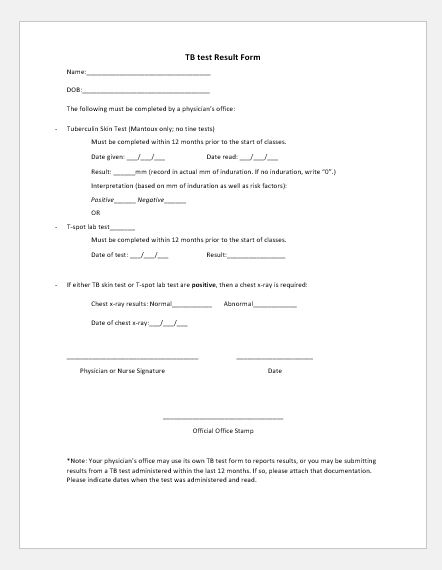
Printable Tuberculosis (TB) Test Forms | Printable Medical Forms, Letters & Sheets
TUBERCULOSIS/MANTOUX SKIN TESTING FORM
Tb Test Form - Fill Online, Printable, Fillable, Blank | PDFfiller
TB Test Form - People Incorporated
TB test Result Form
Mantoux Tuberculin Skin Test Record Form | Mantoux tuberculin skin test record form | PDF4PRO
Tb Test Form - Fill Out and Sign Printable PDF Template | signNow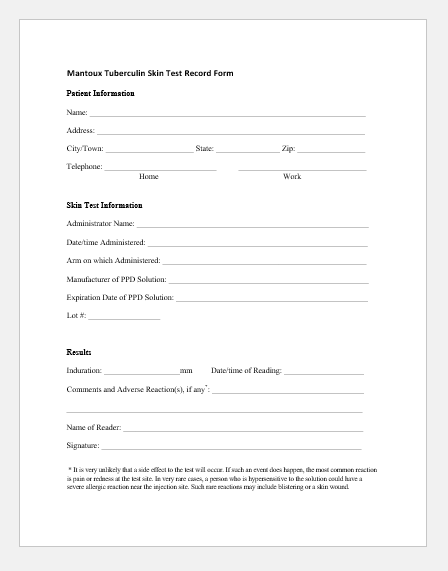
Printable Tuberculosis (TB) Test Forms | Printable Medical Forms, Letters & Sheets
TB PPD Skin Test Screening Form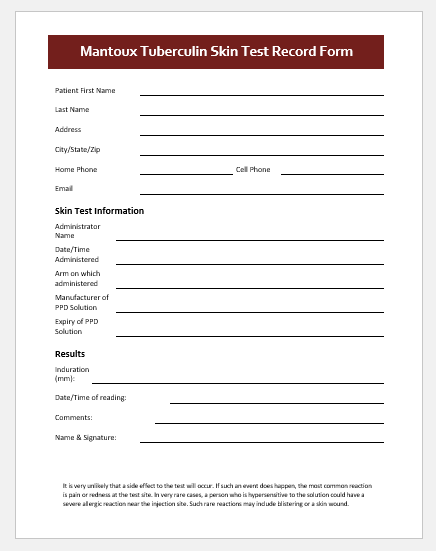
TB Skin Test Record Form Template for Word | Printable Medical Forms, Letters & Sheets
REPORT OF TUBERCULOSIS SCREENING ______ A tuberculin skin test (PPD) is not indicated at this time due to the absence of symptom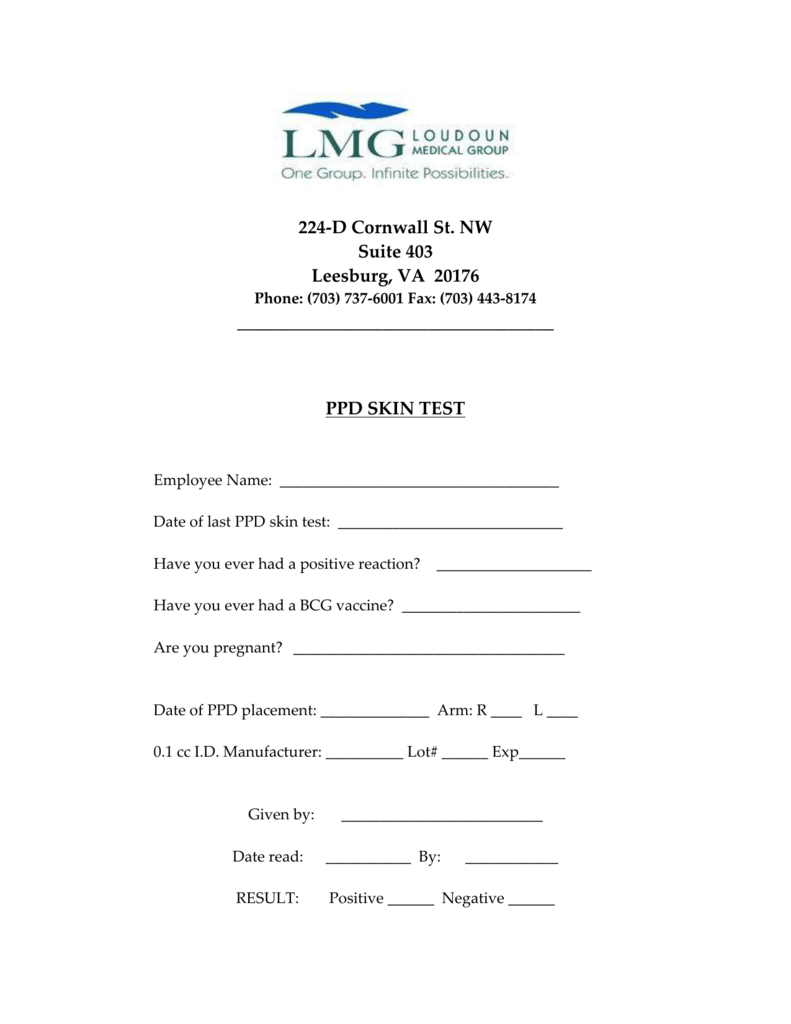
TB Skin Test Form (Employee)
HSIP TB Skin Test Form
Ppd Questionnaire Pdf - Fill Online, Printable, Fillable, Blank | pdfFiller
Blank TB Test Form Printable (Page 1) - Line.17QQ.com
Elegant Tb Skin Test form Template - MODELS FORM IDEAS
Printable TB Test Report
Top 24 Tb Test Form Templates free to download in PDF format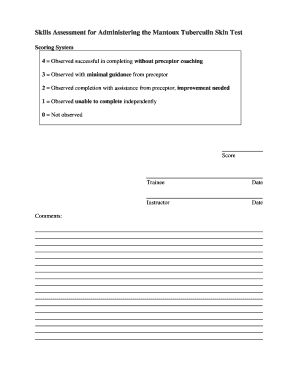
Checklist Mantoux Test - Fill Online, Printable, Fillable, Blank | PDFfiller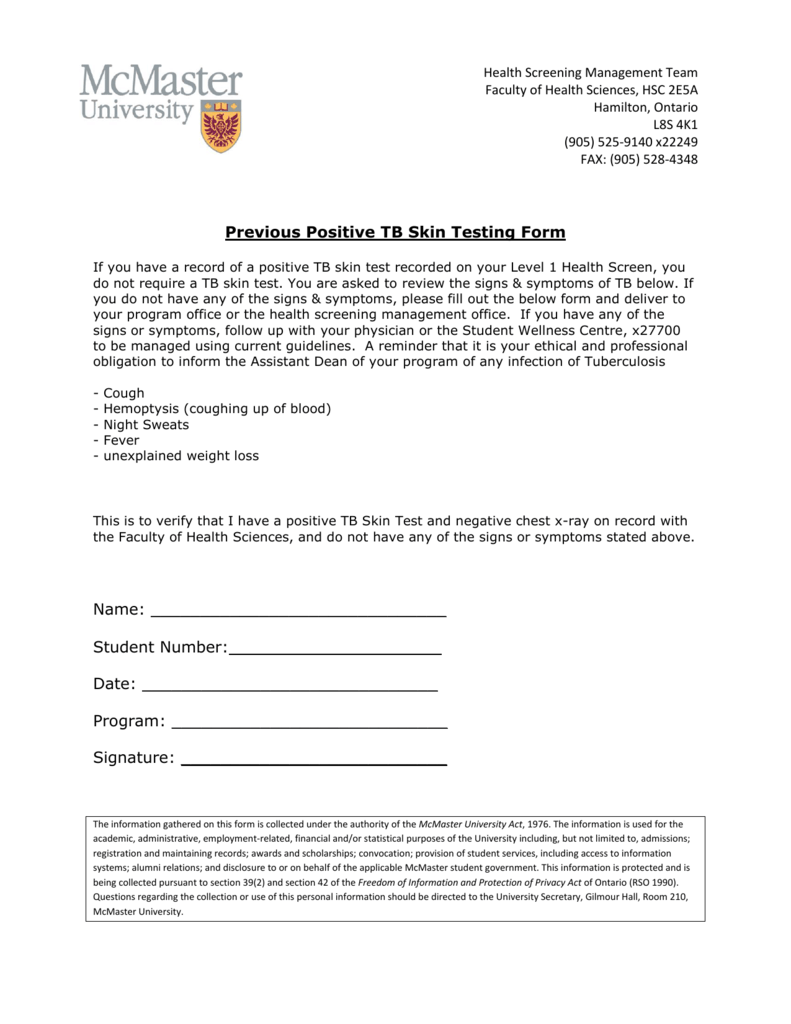
Previous Positive TB Skin Testing Form Name: Student Number
Tuberculin Skin Test Report
TB-Skin-Test-Form raimyndp.doc - 224-D Cornwall St NW Suite 403 Leesburg VA 20176 Phone(305 737-6001 Fax(703 443-8174 PPD SKIN TEST Name_Raymil | Course Hero
Mantoux test - Wikipedia
Tuberculosis Skin Test Procedures Manual
PA Baseline Two-Step PPD - Fill and Sign Printable Template Online | US Legal Forms
Free Printable Tb Skin Test form Brilliant 20 Applicable Emergency Room Patient Discharge Papers - MODELS FORM IDEAS
Ppd Consent Form - Fill Online, Printable, Fillable, Blank | pdfFiller
tb skin test form | Immunology | Animal Diseases
Tuberculosis Skin Test (PPD): Reading, Results, Side Effects & Risks
TUBERCULIN SKIN TESTING TWO-STEP PROTOCOL: FOR INITIAL TESTING IN ADULTS WHO WILL BE UNDERGOING ANNUAL TESTING v2 PURPOSE Approv
Fresh Free Printable Tb Skin Test form - MODELS FORM IDEAS
Tuberculosis Testing Parental Consent Form For Tb Skin Test For Teens Form printable pdf download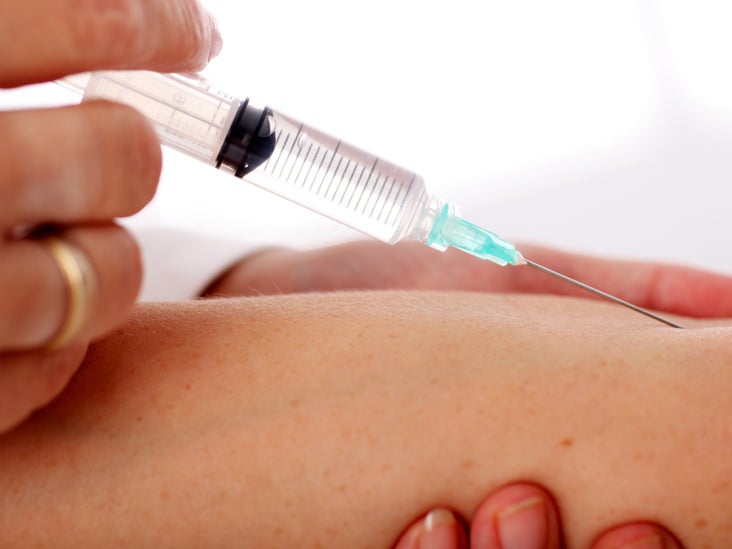
PPD Skin Test (Tuberculosis Test)
TB 2 Step Form
TB Screening Form TDY
 NurseChoice Tuberculosis Skin Test Form 2007 - Fill and Sign Printable Template Online | US Legal Forms
NurseChoice Tuberculosis Skin Test Form 2007 - Fill and Sign Printable Template Online | US Legal Forms





























Posting Komentar untuk "tuberculin skin test forms"